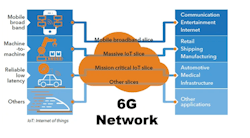Using Integrated Digital Twins to Continuously Assess the 6G Testbed
This article appeared in Electronic Design and has been published here with permission.
What you'll learn:
- What will 6G bring to cellular networks?
- How digital twins could help in the process of developing 6G standards.
- Proposed idea of a 6G testbed with integrated digital twins.
Even as 5G cellular network deployments continue to ramp up within the U.S. and worldwide, major academic programs, research institutes, and commercial R&D operations are turning their focus toward deeper investigations into the promise and realization of 6G technology. Significant government investments have already occurred, and they’re expected to increase dramatically over the next few years. Nations are jockeying for a leadership position in 6G for both commercial and military use cases and seeding early explorations into technology and applications.1
The significant expansions anticipated in all of the usual metrics of cellular communication, including capacity, latency, device density, connection reliability, and other technology growth markers, is well documented.2 Also noteworthy is the burgeoning growth in the number and diversity of devices coming online via the rapidly expanding IoT.
Of course, to name a few areas of substantial growth, these will require significant technology breakthroughs in chipset design, antenna technology, ML-embedded networking, and real-time machine learning.
However, from a broad-based business and consumer perspective, the major impact of 6G is expected to be in the design, deployment, and widespread adoption of a bevy of novel applications that exploit these substantial technological breakthroughs (see figure). Some of the applications being discussed include holographic telepresence, remote surgery, deployment of an autonomous fleet of unmanned vehicles, and deep space or deep ocean exploration.3
The 6G technology breakthrough will need to meet a consistent, predictable, and demanding set of service level agreements (SLAs) to support such diverse applications while adapting to an unprecedented level of system dynamics in a consistent manner.
Pre-Standards Work
Although the initial 6G standards are only expected to be released by 3GPP around 2028, technology exploration, design, and integration efforts by the leading chipset, network equipment, and device vendors as well as service providers are expected to get underway considerably sooner. This leads to an important question: How do we test the impact of technology innovations at the end-to-end system level and their eventual impact on provisioning the application-level SLAs?4
A related concern is in understanding and mitigating any interoperability issues with legacy 5G and perhaps even LTE infrastructures. Security aspects are expected to be built into many of these innovations—how can these be addressed from a system-of-systems rather than a component-level perspective?
Digital engineering in general, and specifically digital twins, offer a unique opportunity to assess the combined impact of these innovations at earlier stages of the product lifecycle, perhaps before significant investments have been made to manufacture, integrate, and deploy them in 6G systems. The use of digital twins, and the potential of digital engineering to shorten product development and deployment lifecycles, has gained increased attention.
Why Digital Twins?
I propose the concept of a 6G integrated digital twin testbed, as a composite of digital twins of the component, device, subsystem, and network elements, constructed at various levels of fidelity and interfaced using standard APIs. We can distinguish such a testbed from other existing and proposed 6G testbeds by its ultimate focus on assessing end-to-end application performance under diverse operating conditions.
The focus of such a testbed is less on assessing the performance or conformance to the specification of individual components. Rather, it’s on establishing how the component when integrated into the system-level deployment will help in the provisioning of end-to-end SLAs.
A common question that arises is how digital twins differ from simulation or emulation models? A key discriminator is the dynamic nature of the model as represented by a digital twin, which refers to its ability to update its state periodically to mimic that of the corresponding physical system that it models.
For instance, in the case of a network digital twin, the model may periodically update the modeled traffic flow or the signal propagation environment, or the position of the transceiver radios, from the physical system. The updates also may come from an AI or ML system that’s periodically updating the digital-twin model attributes based on knowledge of historical events or even an aggregation of runs to synthesize expected behavior.
As more sensors continue to come online via the industrial IoT (IIoT), they will provide a robust data stream that can be mined intelligently to continuously update the digital twins and enhance the accuracy of its predictions.
Such testbeds will enable the broad 6G community to answer a variety of critical questions throughout the course of its development lifecycle—from prioritization of technology areas to architectural tradeoffs, deployment planning, interoperability obstacles and mitigations, to system-level cyber resilience assessments.
6G Testbed with Integrated Digital Twins
Integrated digital twins mean a digital twin that consists of three primary layers:
- A software or services twin that represents the middleware and services that must directly satisfy the application-level SLAs.
- A network digital twin that mimics the establishment and maintenance of the end-to-end communication path over a potentially heterogeneous network incorporating the protocols at the transport, network, link, and physical layers.
- An RF digital twin that captures the behavior of the transceiver devices, antennas, and the signal propagation among communicating neighbors.
The subset of the overall system functionality that’s represented by the digital twin at a particular layer clearly isn’t a strict separation. For instance, it’s very likely that the network digital twin can represent the operation of the physical layer or that it be modeled entirely by the RF layer. Or, the representation may be switched among the two layers based on the level of fidelity for modeling the transmission, which might be required for the specific use case.
An integrated twin may exist entirely as a set of analytical and simulation models (as is very likely to be the case in early stages of the system lifecycle), or it may incorporate live software applications, component emulators, and/or hardware emulators and components in later stages of the system lifecycle development.
It’s natural that such a testbed will evolve over time and incorporate some components or subsystems at much greater levels of fidelity than others. This may be a result of either the specific use case and/or intended application mix, or a natural result of the relative maturity of the corresponding component.
However, the primary focus of the proposed testbed is to appropriately match the market pull of the requirements from the next generation of applications to the technology push of the rapidly evolving and emerging technology elements, and to do so continuously from concept design to eventual system deployment.
References
1. “U.S Underinvesting in 6G Tech,” January 1, 2022, online accessed on August 15 2022.
2. “5G vs. 6G: What is it and when will it be here?,” online accessed on August 16, 2022.
3. “Next G Alliance Report: 6G Applications and Use Cases,” online accessed on August 16, 2022.
4. “When will initial 6G testbeds take place?,” December 17, 2021, online accessed on August 16, 2022.
About the Author
Dr. Rajive Bagrodia
General Manager, Scalable Networks Aerospace Defense & Government Solutions, Keysight Technologies, and Emeritus Professor, UCLA
Dr. Rajive Bagrodia is General Manager (Scalable) in the ADGS Group at Keysight Technologies. Previously, he was the Founder and CEO of Scalable Network Technologies, Inc. SCALABLE, founded in 2001, was acquired by Keysight in September 2021. Dr. Bagrodia also an Emeritus Professor of Computer Science at UCLA.
Together with his team at UCLA and SCALABLE, he has published over 175 research papers on parallel simulation, high-performance computing, wireless communications, and network digital twins. At SCALABLE, Dr. Bagrodia led the company to become a leader in the design and use of network digital twins to assess performance and cyber resilience of a diverse set of networked systems.
Rajive obtained his Ph.D. in Computer Science from the University of Texas at Austin and his B.Tech. in Electrical Engineering from the Indian Institute of Technology, Bombay.

